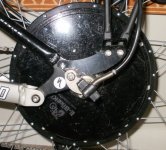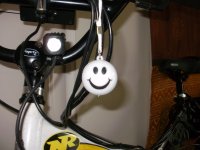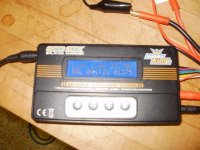geetarboy said:
Usually 99.4 or 5 hot off the chargers to be more precise. Powered by 24s2p lipo and channeled through an 18fet 72volt 65amp Lyen controller, the motor can get rather toasty after a 7 mile suburban sprint keeping up with 40 mile an hour traffic. I have thought about drilling holes in the side covers like some of you other "overvolters" have done, but I want to keep it waterproof as much as possible. The Cycle Analyst is indispensible for monitering performance and protecting the precious lipo, as I cruise along BMSless. All components are performing outstanding up to this point - knock on wood - Let's see what the next 1000 miles bring...

geetarboy - Very Cool Setup Indeed!
Before you go putting holes in the motor - there may be some configuration things you could do much simpler without fear of allowing moisture to enter the hub and degrade performance... In addition, since you have acheived 1000mi at this voltage and you have a CA - some additional details would be beneficial to me personally but also to the community!
In addition - I've not put 1000mi on anything 100v but I have tested the 9C motors - of various versions and revisions (new and old) and may (I stress may) be able to walk you through some basic stuff (and some not so obvious things) to increase the reliability of your setup, the efficiency and also perhaps alter your setup a tad to reduce the motor heat after 7mi continuous useage in suburban 40mph traffic at the same time (without comprimising your power levels).
Would you mind clarifying a few items and bits of information?
#0.) What do you consider hot after 7mi ride?
#1.) Your 9C Rear?
a.) Stock? (you haven't upgraded the phase wires, bearings, etc?) - If you've upgraded the motor or wireing somehow, please elaborate

b.) RH205 model - 9x7 Winding on a 26" Wheel?
c.) No load speed, voltage and current (if you measured it yet, if not I can explain how)
#2.) Lyen 18FET, 72v - 65A Controller ?
a.) I assume the 4110 FETs model?
b.) Have you modified its hardware at all (resistors, beefed tracing, etc)?
c.) Have you programmed it with Parameter Designer or are you running the stock setup?
d.) Did the controller arrive configured for 72v from Lyen? - Did you change R1A for the 100v setup?
e.) Did the controller arrive configured for 65a from Lyen? - Do you know what he set the phase current?
#3.) Sorry but how much do you, your bike and batteries weigh (ballpark) in kG or lbs?
#4.) Do you have the serial / ttl output / logging ability from the CA and a PC to log to?
Just to clarify - part of the isse your having, at maximum power - you are drawing 6474 watts or 8.632 hp from the pack into the controller/motor. The output power (assuming 80% efficiency) is: 5768.8 or 7.6917 hp.
The issue is at that voltage and yoru currnet numbers and calibration your generating 705 watts or .9hp of PURE HEAT in the motor.
Remember the bearings on the covers which make it all work are rated for 30mph maximum on a 26" or 349.44 RPM at best - pushing them farther just generates more heat - replacing the bearings with some better (HIGH END) could actually increase efficiency and reduce heat

-Mike








